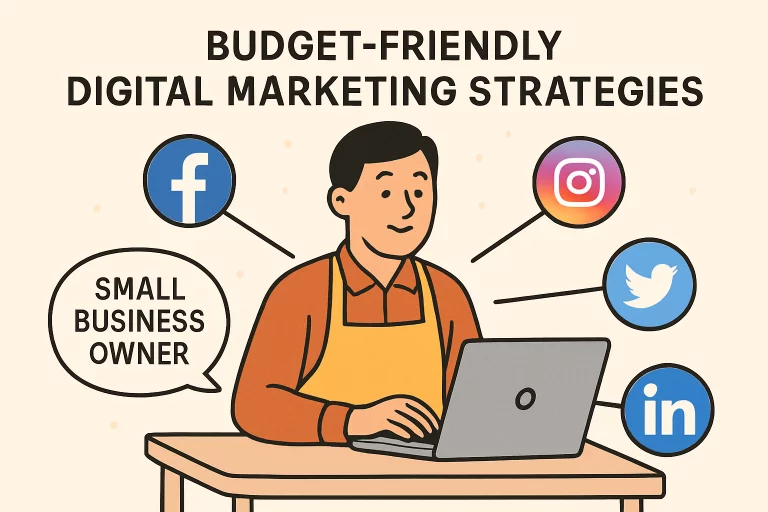In today’s digital landscape, social media marketing has become essential for small businesses aiming to expand their reach, establish a strong brand presence, and cultivate lasting customer relationships. However, small businesses frequently face the daunting challenge of limited resources, budget constraints, and a lack of dedicated marketing teams. This can make effective social media management seem unattainable. Thankfully, affordable social media solutions make it possible to achieve outstanding results without breaking the bank. By adopting cost-effective strategies and making savvy use of available tools, small business owners can build robust connections with their audience while maximizing the impact of every marketing dollar spent. This comprehensive guide is tailored specifically for small business owners who want to harness the power of social media without straining their budgets. We will explore a variety of approachable, budget-friendly strategies designed to produce meaningful engagement, organic reach, and tangible business growth. By the end, you’ll understand how your investment—however modest—can lead to measurable improvements in brand visibility and customer loyalty.
Table of Contents
Understanding Your Audience
The backbone of any successful social media marketing is the audience. Start by creating detailed buyer personas that encompass key demographic details such as age, gender, location, job roles, interests, challenges, and the social platforms they frequent most. Delve into audience research by analyzing your current customer base, surveying your followers, and reviewing the types of content your audience shares and responds to. For instance, visually appealing brands—such as clothing boutiques or photography studios—often find Instagram and Pinterest to be their strongest platforms due to their visual nature, while businesses targeting other professionals, like B2B services or consultancies, typically perform better on LinkedIn.
Additionally, take the time to observe your competitors’ media efforts. Analyze which posts seem to drive the most interactions, and look for gaps in their strategies that you can fill. This research helps inform your content creation, ensuring it is visible to the audience and positioned to deliver content that genuinely resonates with them. The deeper your understanding of your potential customers’ preferences, the easier it becomes to personalize your messaging, drive higher engagement, and ultimately increase sales.
Leveraging Free Tools
One of the most efficient ways to stretch your marketing budget is by taking full advantage of free, low-cost tools designed to streamline social media management. These tools can save time, enhance content quality, and offer valuable data to inform your targeting and messaging strategies.
- Canva: Canva is a user-friendly graphic design platform that enables small businesses to create stunning visuals without needing professional design skills. With its vast templates for posts, stories, ads, and covers, businesses can maintain a cohesive visual identity and churn out branded content in minutes.
- Buffer: Managing multiple social platforms can quickly become overwhelming. Buffer allows users to schedule and publish posts ahead of time on various platforms, ensuring constant brand visibility and helping to maintain a consistent posting cadence—even during busy periods.
- Google Analytics: This invaluable tool tracks where your web traffic comes from, which social channels drive the best results, and what content leads to the most conversions. This knowledge enables small businesses to optimize their marketing strategies and focus efforts where they yield the most return.
Most social platforms also provide built-in analytics that reveal follower growth, engagement rates, and content performance. By consistently reviewing this data, you can make informed decisions about what types of posts work best and efficiently allocate your limited resources for maximum impact. For even more tips and resources on free marketing tools, check out this list of top-rated free social media tools.

Creating Engaging Content
Great content is at the heart of every successful social media strategy. To genuinely engage your audience, focus on delivering content that educates, entertains, or inspires—always with your target customers’ needs in mind. Consider sharing helpful how-to videos, insightful blog articles, exciting behind-the-scenes looks at your business, and customer or employee spotlights to bring your brand to life and keep your message fresh. Developing and following a content calendar allows you to plan posts ahead of time, schedule content around holidays or promotional events, and maintain consistent interaction with your followers. Incorporating a diverse mix of media—including images, short-form videos, infographics, and interactive polls—keeps your feed dynamic and increases the likelihood of engagement. Social algorithms typically reward posts that stimulate meaningful interactions, so prioritize content types, like stories, live videos, and user polls, that spark conversation and prompt viewers to take action.
Tips for Crafting Compelling Posts
- Ask open-ended questions to invite audience participation and thoughtful responses.
- Stay relevant by including trending topics, memes, and time-sensitive content that appeals to your audience and current events.
- Balance your content mix by rotating between images, video clips, infographics, and copy-based updates to appeal to different audience preferences.
An ongoing commitment to creative, relevant, and consistent content will boost your organic reach, deepen audience loyalty, and encourage existing customers to advocate for your brand online.
Utilizing User-Generated Content
User-generated content (UGC) is one of the most authentic, cost-effective ways to highlight your brand and build trust. UGC includes customer reviews, testimonials, unboxing videos, or photos of customers enjoying your products or services. Small businesses can encourage users to generate and share content by running hashtag campaigns, hosting photo contests, or simply asking customers to tag the business in their posts. This approach creates a sense of community and allows loyal fans to participate in your brand. When you actively showcase user content on your feed or in stories, you fill your content pipeline with relatable posts and demonstrate appreciation for your customers. For example, a local coffee shop might repost photos of customers using a branded mug, or a boutique could share customer testimonials in story highlights. Featuring real customers strengthens credibility, boosts engagement, and inspires others to share their experiences, growing your organic reach at little to no cost.
Collaborating with Influencers
Influencer marketing is sometimes perceived as an expensive strategy reserved for large brands, but it’s surprisingly accessible for small businesses when approached strategically. Micro-influencers—individuals with highly engaged followings in the 1,000-10,000 range—often deliver excellent results for a fraction of the investment required for celebrity partnerships. Since these influencers frequently appeal to niche, tightly knit communities, their endorsements are seen as more genuine and trustworthy. Identify local influencers or those within your industry who share your values and serve your target audience. Simple collaboration ideas include offering your product in exchange for a review, co-hosting an Instagram Live session, or arranging a small giveaway. These partnerships can introduce your brand to new customers, increase social proof, and even provide you with reusable content across platforms. Successful collaborations are built on authenticity, so always prioritize influencers authentically aligning with your brand’s values and voice.
Running Contests and Giveaways
Contests and giveaways are proven tactics for rapidly building brand awareness, growing your follower base, and increasing post engagement. To encourage maximum participation, design your contest with low-barrier requirements, such as liking a post, following your account, tagging friends, or sharing the post with stories. Prizes don’t have to be expensive; branded merch, sample products, or exclusive discount codes are often enough to excite potential participants. Consider collaborating with another local business to co-host a giveaway, which enables both brands to tap into each other’s audiences and share promotional costs. After the contest ends, keep the momentum going by sending a thank-you message to participants and offering them an exclusive deal for sticking around. Well-executed contests keep your audience engaged, increase your brand’s visibility, and create a sense of community on your page.
Analyzing and Adjusting Strategies
Smart, cost-effective marketing always relies on ongoing data analysis and the flexibility to adapt. To assess the performance of your efforts, take full advantage of native analytics on platforms like Facebook, Instagram, and LinkedIn, along with third-party tools and Google Analytics. Key metrics to monitor include reach, impressions, engagement rate, comments, click-through rate, and conversions. Pay attention to which types of content yield the highest and when, at times, and on days your audience is most active. Use these insights to refine your schedule, shift your content mix, and continually optimize your messaging. By consistently analyzing and adjusting your strategy, you ensure you’re staying within your budget on the initiatives most likely to drive measurable results and generate the best possible ROI for your business. Implementing these wallet-friendly social media marketing strategies will empower your small business to connect authentically with target audiences, develop valuable customer relationships, and see real business growth—all without overspending. Explore affordable social media solutions designed to help small businesses thrive with more tailored advice and professional guidance. You’ll sustain success from your social media investment by combining the right tools, authentic engagement, and ongoing data-driven tweaks.




